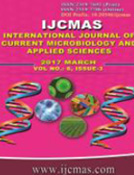


 National Academy of Agricultural Sciences (NAAS)
National Academy of Agricultural Sciences (NAAS)

|
PRINT ISSN : 2319-7692
Online ISSN : 2319-7706 Issues : 12 per year Publisher : Excellent Publishers Email : editorijcmas@gmail.com / submit@ijcmas.com Editor-in-chief: Dr.M.Prakash Index Copernicus ICV 2018: 95.39 NAAS RATING 2020: 5.38 |
Cowpea (Vigna unguiculata (L.)Walp.) is a poor men’s protein source. It is one of the most ancient human food sources and an important grain legume and hay crop in many tropical and subtropical regions. It is grown in Tamil Nadu and Andhra Pradesh widely as rainfed crop. Cowpea is affected by many diseases caused by viruses, bacteria and fungi. Among the fungal diseases, the charcoal rot caused by Macrophomina phaseolina (Tassi.) Goid causes significant loss in yield. M. phaseolina is a soil borne plant pathogen with a very wide host range. The studies were initiated with survey on the dry root rot incidence of cowpea in Cuddalore, Thiruvannamalai and Vellore districts of Tamil Nadu revealed endemic nature of the root rot disease incidence of cowpea. Among the different locations of Cuddalore, Thiruvannamalai and Vellore districts surveyed for cowpea root rot incidence, Sukkanampatti (MP10) registered the maximum incidence of the disease (25.84%) followed by Keelakalpoondi , Keeranur and Sivapuri. The other locations viz., Kadavacheri, Perumathur, Varakoorpettai and Simanamputhur had moderate disease incidence while the minimum root rot incidence was recorded in Thanippadi and Chittur. In general, the crop grown under rainfed conditions showed more root rot incidence when compared with the crops grown under irrigated conditions. The variations in root rot incidence could be well attributed to the difference in virulence of the isolates of M. phaseolina prevalent in the respective areas. The survey revealed that higher levels of disease incidence in rainfed crop than that of irrigated crop. The dry condition prevalent in the rainfed conditions might have favoured the pathogen which could be attributed as the reason for the higher level of disease incidence.
 |
 |
 |
 |
 |